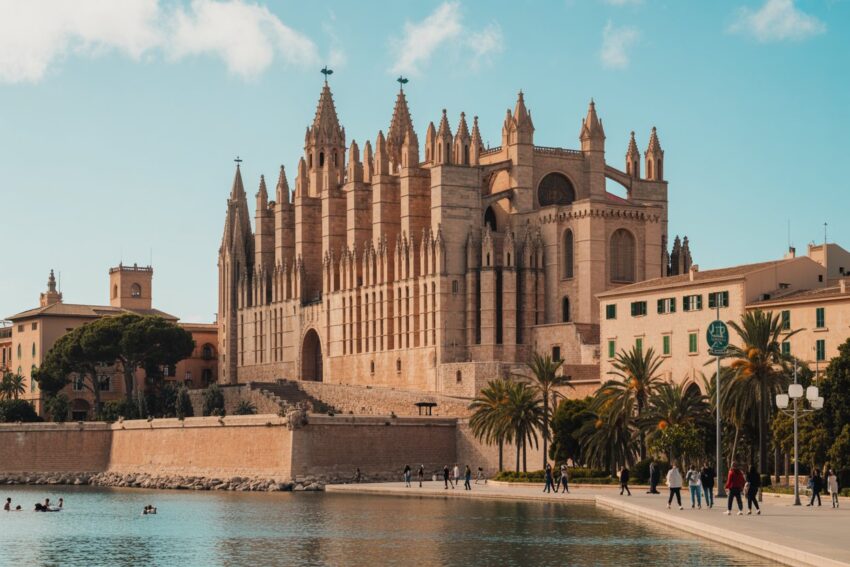Palma’s New Tourism Policies: Reducing Crowds and Focusing on Responsible Travel – Travel And Tour World

Report on Palma de Mallorca’s New Tourism Policies and Alignment with Sustainable Development Goals (SDGs)
This report analyzes the new tourism policies announced by Palma de Mallorca, scheduled for implementation from 2026. The policies represent a strategic pivot from mass tourism towards a sustainable model, directly addressing challenges of over-tourism and aligning with the United Nations’ Sustainable Development Goals (SDGs). The core objective is to reposition Palma as a destination for high-quality, low-impact travel, thereby safeguarding its environmental and cultural assets for future generations.
Strategic Interventions for Sustainable Urban Development
Palma’s new framework is designed to mitigate the negative externalities of mass tourism, directly contributing to SDG 11: Sustainable Cities and Communities. The city aims to make its urban spaces more inclusive, safe, resilient, and sustainable by managing tourism pressures.
- Reduction of Visitor Capacity: A primary policy is the targeted reduction of annual visitors by half a million by 2027. This measure aims to alleviate strain on public infrastructure, services, and housing.
- Regulation of Tourist Accommodations: The city will halt the construction of new youth hostels and limit the expansion of holiday rentals. This action directly addresses Target 11.1 by seeking to ensure access to adequate, safe, and affordable housing for residents and curbing the inflation of the local property market driven by short-term rentals.
- Protection of Cultural and Natural Heritage: By reducing crowd density, the policies will help safeguard Palma’s cultural landmarks, such as the Palma Cathedral and Bellver Castle, in line with Target 11.4, which calls for strengthening efforts to protect and safeguard the world’s cultural and natural heritage.
Fostering Sustainable Economic Growth and Responsible Consumption
The strategy emphasizes a shift towards a more sustainable economic model, aligning with SDG 8: Decent Work and Economic Growth and SDG 12: Responsible Consumption and Production.
- Promotion of High-Value Tourism: The focus is shifting from volume to value, encouraging cultural and historical exploration over mass-market tourism. This supports Target 8.9, which aims to devise and implement policies to promote sustainable tourism that creates jobs and promotes local culture and products.
- Ban on Party Boats: The prohibition of party boats, or “booze cruises,” is a significant step towards responsible tourism. This measure curtails activities associated with environmental degradation and social disruption, fostering a more sustainable and family-friendly tourism image.
- Encouraging Sustainable Activities: The city will promote environmentally conscious activities like guided nature excursions and responsible water sports. This approach supports the development of sustainable tourism tools (Target 12.b) that monitor impacts and create a more responsible consumption pattern among visitors.
Commitment to Environmental Protection
A key component of the new policies is the protection of Palma’s natural environment, particularly its marine ecosystems, which is a direct contribution to SDG 14: Life Below Water.
- Mitigating Marine Pollution: The ban on party boats directly addresses Target 14.1, which aims to prevent and significantly reduce marine pollution of all kinds. These vessels are often sources of noise pollution, waste, and congestion in coastal areas.
- Preservation of Coastal Integrity: By encouraging low-impact water activities, the city promotes the sustainable use of marine resources, ensuring the long-term health and beauty of its coastline.
Projected Outcomes and Future Outlook
The implementation of these policies is expected to yield significant benefits for residents, tourists, and the environment, establishing Palma as a global model for sustainable urban tourism.
Conclusion: A New Era of Responsible Tourism
Palma de Mallorca’s new tourism strategy marks a decisive move towards sustainability. By regulating visitor numbers, controlling tourist accommodation growth, and banning environmentally harmful activities, the city is taking concrete actions to protect its community and heritage. These policies are deeply integrated with the principles of the Sustainable Development Goals, particularly SDGs 8, 11, 12, and 14, positioning Palma as a leader in responsible tourism management and ensuring its long-term viability as a premier cultural destination.
Analysis of Sustainable Development Goals in the Article
1. Which SDGs are addressed or connected to the issues highlighted in the article?
-
SDG 8: Decent Work and Economic Growth
The article discusses Palma’s shift from mass tourism to “high-quality, low-impact tourism.” This new model aims to create a more sustainable economic foundation by promoting “cultural exploration and relaxation” rather than focusing on volume. This relates to creating sustainable economic growth through responsible tourism.
-
SDG 11: Sustainable Cities and Communities
This is a central theme. The article highlights Palma’s efforts to manage overcrowding, reduce strain on local infrastructure, protect its housing market from the negative impacts of short-term rentals, and preserve the quality of life for its residents. The policies aim to make the city more inclusive, safe, resilient, and sustainable for both residents and tourists by safeguarding its cultural and natural heritage.
-
SDG 12: Responsible Consumption and Production
The article describes Palma’s new policies as a move towards “sustainable tourism practices.” By reducing the number of visitors and implementing restrictions on certain types of tourism (like party boats and mass holiday rentals), the city is actively managing its consumption of resources and promoting more responsible patterns of tourism production and consumption.
-
SDG 14: Life Below Water
The specific measure to ban party boats directly addresses this goal. The article states that these boats have caused “significant environmental damage, excessive noise, and congestion along Palma’s coast.” The ban is an effort to prevent and reduce marine pollution and protect the coastal ecosystem.
2. What specific targets under those SDGs can be identified based on the article’s content?
-
Target 8.9: “By 2030, devise and implement policies to promote sustainable tourism that creates jobs and promotes local culture and products.”
The article explicitly details Palma’s new policies aimed at promoting “sustainable and responsible travel.” The focus on “cultural tourism” by promoting sites like the Palma Cathedral and Bellver Castle directly aligns with promoting local culture as a cornerstone of the tourism strategy.
-
Target 11.4: “Strengthen efforts to protect and safeguard the world’s cultural and natural heritage.”
The article states that the policies aim for “the preservation of its natural beauty and local heritage.” The shift away from mass tourism is a direct effort to reduce the strain on the city’s historic charm and cultural sites, thereby safeguarding them for the future.
-
Target 11.1: “By 2030, ensure access for all to adequate, safe and affordable housing…”
The article connects over-tourism directly to the housing crisis, noting that the “rise of short-term vacation rentals has caused housing prices to soar, making it increasingly difficult for residents to find affordable accommodations.” The policy to cap the growth of youth hostels and tourist apartments is a direct measure to address this target by protecting the local housing market.
-
Target 12.b: “Develop and implement tools to monitor sustainable development impacts for sustainable tourism…”
Palma’s entire policy package, including the specific goal to “reduce the number of visitors to Palma by half a million annually by 2027,” serves as a tool to manage and monitor the impacts of tourism. This quantitative goal is a clear implementation of a monitoring framework for sustainable tourism.
-
Target 14.1: “By 2025, prevent and significantly reduce marine pollution of all kinds…”
The “ban on party boats” is a direct action to combat marine pollution. The article links these boats to “environmental damage” along the coast, and the ban is a preventative measure to reduce this specific source of pollution.
3. Are there any indicators mentioned or implied in the article that can be used to measure progress towards the identified targets?
- Reduction in visitor numbers: The article provides a specific, measurable indicator: “to reduce the number of visitors to Palma by half a million annually by 2027.” This directly measures progress towards managing tourism flows (Target 12.b).
- Restrictions on tourist accommodations: The policies to “halt the construction of new youth hostels” and limit the “growth of holiday rentals” are clear indicators. Progress can be measured by tracking the number of new licenses issued for such accommodations, which relates to protecting the housing market (Target 11.1).
- Implementation of the party boat ban: The “ban on party boats” is a binary indicator (either it is in effect or not). Its success can be further measured by monitoring the number of illegal party boat operations and assessing the reduction in related environmental complaints and damage (Target 14.1).
- Shift in tourism focus: While less quantitative, a shift can be indicated by tracking the marketing focus of the city, the types of new tourism activities promoted (e.g., “guided sailing tours, nature excursions”), and analyzing visitor demographics to see if they align with the goal of attracting “visitors interested in authentic experiences” (Target 8.9).
4. Summary of SDGs, Targets, and Indicators
| SDGs | Targets | Indicators |
|---|---|---|
| SDG 8: Decent Work and Economic Growth | 8.9: Promote sustainable tourism that creates jobs and promotes local culture and products. | Implementation of policies focusing on “high-quality, low-impact tourism” and promotion of cultural sites like Palma Cathedral and Bellver Castle. |
| SDG 11: Sustainable Cities and Communities | 11.4: Strengthen efforts to protect and safeguard the world’s cultural and natural heritage. 11.1: Ensure access for all to adequate, safe and affordable housing. |
Policies aimed at preserving local heritage by reducing overcrowding. Halting construction of new youth hostels and limiting holiday rentals to protect the local housing market. |
| SDG 12: Responsible Consumption and Production | 12.b: Develop and implement tools to monitor sustainable development impacts for sustainable tourism. | The specific, measurable goal to “reduce the number of visitors to Palma by half a million annually by 2027.” |
| SDG 14: Life Below Water | 14.1: Prevent and significantly reduce marine pollution of all kinds. | The complete “ban on party boats” to mitigate environmental damage and noise pollution along the coast. |
Source: travelandtourworld.com
What is Your Reaction?
 Like
0
Like
0
 Dislike
0
Dislike
0
 Love
0
Love
0
 Funny
0
Funny
0
 Angry
0
Angry
0
 Sad
0
Sad
0
 Wow
0
Wow
0


















































.jpg.webp?itok=0ZsAnae9#)



/environment-climate-change-and-health-(ech)/water-sanitation-hygiene-and-health-(wsh)/landfill-tuvalu-36092.tmb-1200v.jpg?sfvrsn=5c21fe40_1#)





















